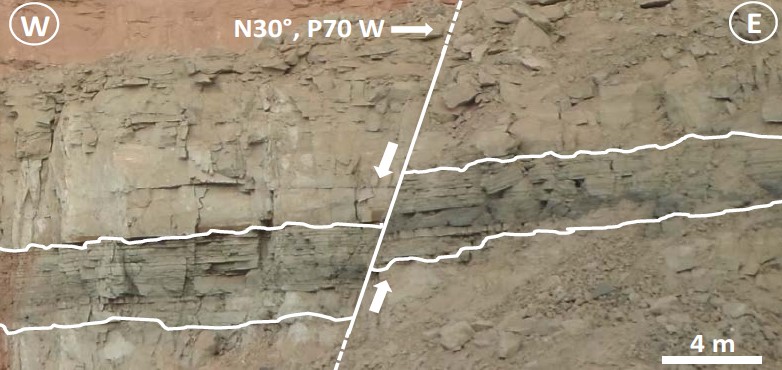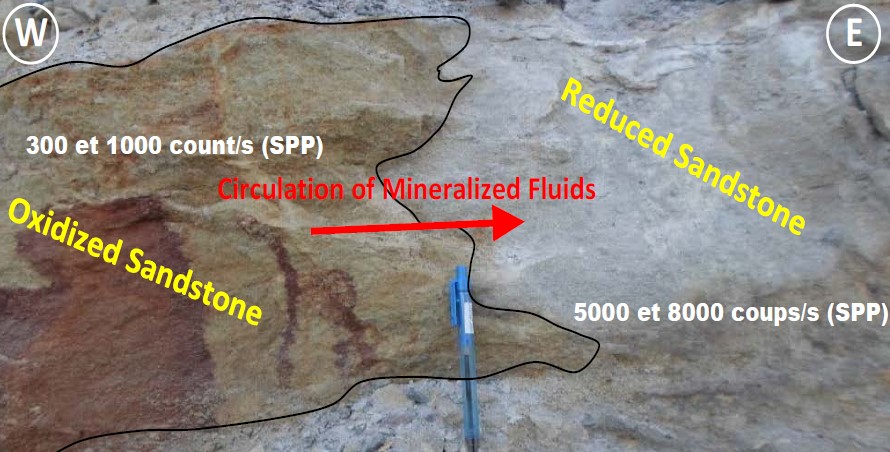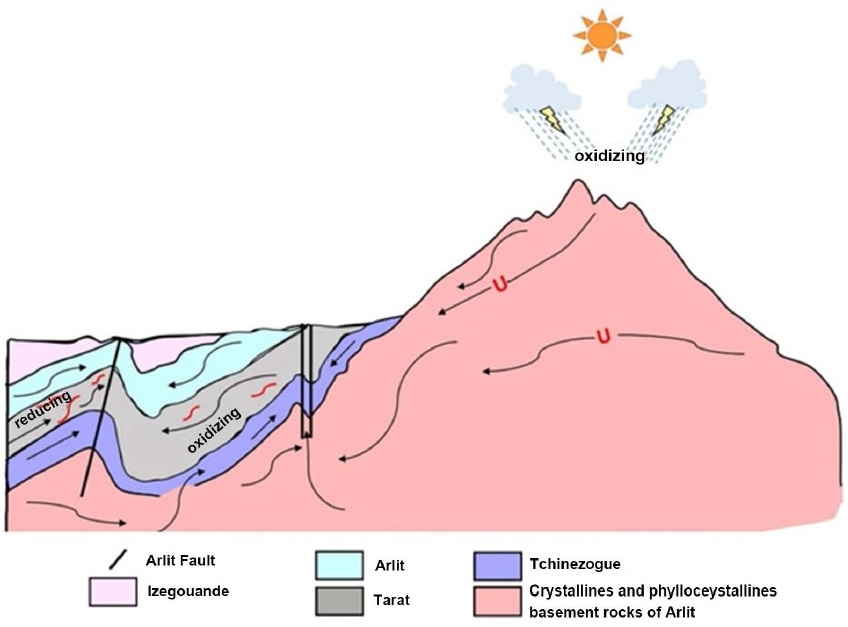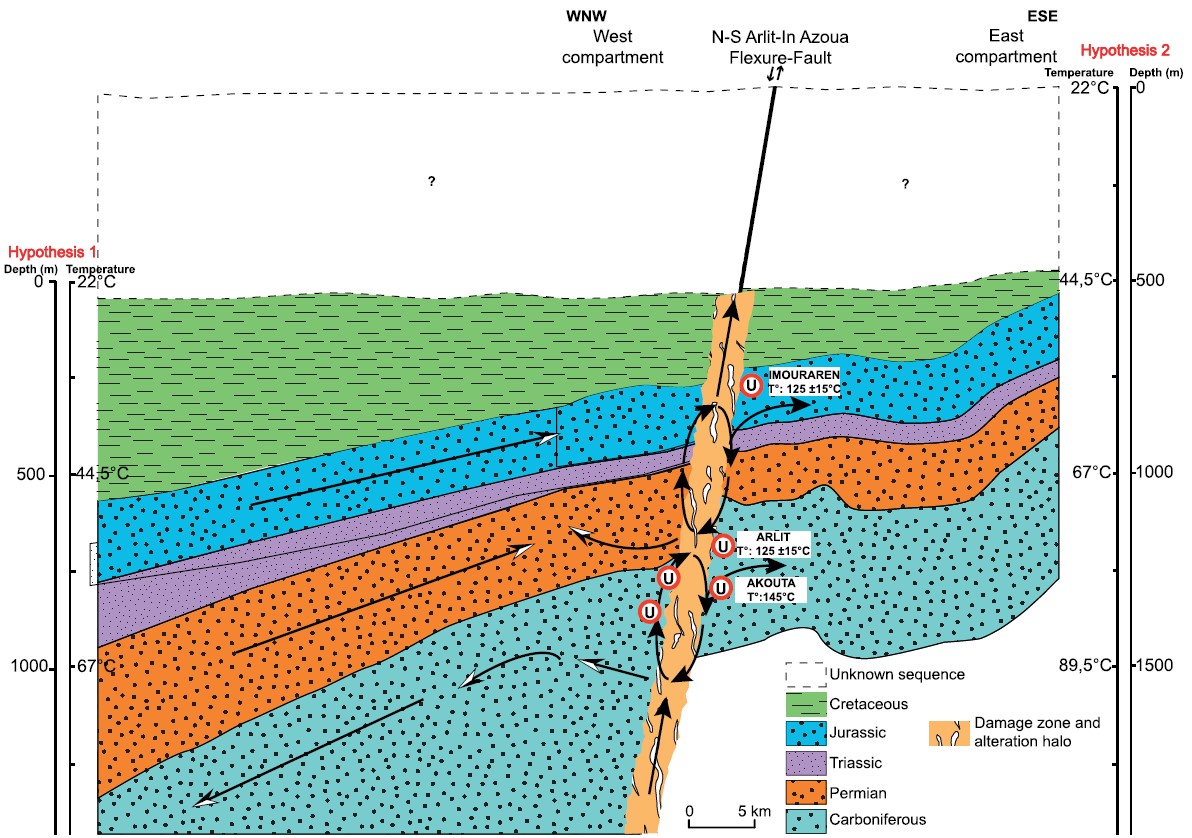Tarat Fm
Type Locality and Naming
Group/Subgroup: Upper Tagora Gr
References: Claret & Tempère, 1968; Fabre et al., 1983; Sempere et al., 1984; Broutin et al., 1990; Coquel et al., 1995; Wagani et al., 2011; Mamadou et al., 2016; Billon et al., 2016; Bohari et al., 2018; Alfidja et al., 2021.
Synonym: "Grès de Tarat"; Lower and Middle Tarat of earlier authors (their upper part of the Tarat being the currently known Madaouela Fm
Lithology and Thickness
Coarse-grained sandstones. Impermeable shale/mudstone units are interbedded in the sedimentary sequence and often occur immediately above and below the uranium-mineralized sandstone, which SOMAÏR has mined for more than 15 years. The uranium mineralization is disseminated as pitchblende, which gives the sandstone a yellow color while molybdenum mineralization gives a blue color to the sandstone (Fig. 3). The sandstone is classified into proto-quartzite (i.e. litharenite and sublitharenite), arkose, subarkose, wacke and quartz arenite and varied in their maturity. It is rich in organic matter (plant debris). The provenance of the sedimentary materials and uranium mineralization has been demonstrated to come from the dismantling of crystalline and crystallophyllic rocks of the Aïr massif (Fig. 4), to annular complexes of Zinder-Nigeria region, to volcanic alkaline emissions formed from emission of acid magmas and to the emplacement of plutons along major accidents such as that of Arlit (Fig. 1, Fig. 5). In some areas, the Tarat formation is divided into four sequences:
- Unit 4 (U4) consists of reduced gray fine consolidated sandstone alternating clay-silt (Fig. 2)
- Unit 3 (U3) is composed of coarse to medium sandstone with an increasing presence of micro-conglomerate towards the bottom
- Unit 2 (U2) is characterized by reduced fine gray sandstone with kaolinitic cement
- Unit 1 (U1) consists of coarse to micro-conglomerate gray sandstone
Thickness: ~50 m. Claret & Tempère (1968) mention 15 m in their section #3
[Figure 1. Tarat Fm in Takriza is characterized by major accident N30° (Source: Bohari et al., 2018).]
[Figure 2. Tarat Fm in Taza North shows the presence of oxidized and reduced sandstones. (Source: Bohari et al., 2018).]
[Figure 3. The Tarat Fm in the Tamou open-pit mine indicates an alternation of gray coarse-grained sandstone and clay-silt with cross-stratification (Source: Bohari et al., 2018).]
[Figure 4. Genesis model for Tarat Fm sandstone-type uranium deposit (Source: Bohari et al., 2018).]
[Figure 5. A model for hot fluid flux in the Carboniferous and Jurassic aquifers of the Tim Mersoï Sub-Basin. The Guezouman Fm hosts the Akouta uranium deposit; the Arlit deposit is found in the Tarat Fm, and the Imouraren uranium deposit is located in the continental arkoses and analcime-rich sandstones of the Tchirezrine 2 Fm (Source: Mamadou et al., 2016; Mamadou, 2016).]
Relationships and Distribution
Lower contact
Underlain by the Tchinezogue Fm
Upper contact
Overlain by the Madaouela Fm or Arlit Fm
Regional extent
GeoJSON
Fossils
Age
Depositional setting
Continental fluvio-deltaic sedimentary environment affected by passive margin tectonic setting. [See Fig. 5]
Additional Information
Earlier, the mining town of Arlit used water from the aquifer of the Tarat Formation. However, its overexploitation due to the development of mining activities and the resulting increase in the population led to a drastic drawdown of the groundwater level (Alfidja et al., 2021).




